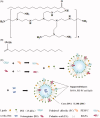Delivery of antisense oligonucleotide using polyethylenimine-based lipid nanoparticle modified with cell penetrating peptide
- PMID: 31544540
- PMCID: PMC6764372
- DOI: 10.1080/10717544.2019.1667453
Delivery of antisense oligonucleotide using polyethylenimine-based lipid nanoparticle modified with cell penetrating peptide
Abstract
Efficient and stable delivery system of antisense oligonucleotide (ASO) is important and urgently needed. Here, an ASO delivery system, Lp-PPRP, which contains a cationic polymer based on PEI (branched, 25 kDa), named PEI-PC and a palmitic acid modified R8 (R8-PA) was prepared to deliver a kind of ASO, LOR-2501. The characteristics of the nanoparticles and the cellular uptake of LOR-2501 in HeLa cells and A549 cells were studied. Lp-PPRP showed suitable particle size and zeta potential to combine with LOR-2501; the particle size and zeta potential of Lp-PPRP/LOR were 276.87 ± 5.63 nm and 18.03 ± 0.25 mV. In vitro experiments suggested that Lp-PPRP had lower cytotoxic and higher transfection efficiency for delivering LOR-2501 compared with PEI. The addition of PEI-PC and R8-PA contributed to enhance the transfection efficiency of the nanoparticles. In HeLa cells and A549 cells, Lp-PPRP could transport LOR-2501 and down-regulate the level of R1 protein efficiently, and the R1 down regulations were 64.56% and 66.34%, respectively. Results suggested potential utility of Lp-PPRP in the development of ASO in tumor therapy.
Keywords: Polyethylenimine; antisense oligonucleotide; cancer; cell penetrating peptide; lipid nanoparticles.
Figures







Similar articles
-
Delivery of Antisense Oligonucleotide LOR-2501 Using Transferrin-conjugated Polyethylenimine-based Lipid Nanoparticle.Anticancer Res. 2019 Apr;39(4):1785-1793. doi: 10.21873/anticanres.13285. Anticancer Res. 2019. PMID: 30952718
-
Enhanced antisense oligonucleotide delivery using cationic liposomes incorporating fatty acid-modified polyethylenimine.Curr Pharm Biotechnol. 2014;15(9):800-5. doi: 10.2174/138920101509141107122927. Curr Pharm Biotechnol. 2014. PMID: 25403516
-
Non-covalent complexes of folic acid and oleic acid conjugated polyethylenimine: An efficient vehicle for antisense oligonucleotide delivery.Colloids Surf B Biointerfaces. 2015 Nov 1;135:274-282. doi: 10.1016/j.colsurfb.2015.07.047. Epub 2015 Jul 26. Colloids Surf B Biointerfaces. 2015. PMID: 26263216 Free PMC article.
-
Targeted lipid nanoparticles for antisense oligonucleotide delivery.Curr Pharm Biotechnol. 2014;15(9):847-55. doi: 10.2174/1389201015666141020155834. Curr Pharm Biotechnol. 2014. PMID: 25335532 Review.
-
Lipid Nanovesicles in Cancer Treatment: Improving Targeting and Stability of Antisense Oligonucleotides.Drug Des Devel Ther. 2025 Feb 14;19:1001-1023. doi: 10.2147/DDDT.S507402. eCollection 2025. Drug Des Devel Ther. 2025. PMID: 39967902 Free PMC article. Review.
Cited by
-
cRGD peptide-conjugated polyethylenimine-based lipid nanoparticle for intracellular delivery of siRNA in hepatocarcinoma therapy.Drug Deliv. 2021 Dec;28(1):995-1006. doi: 10.1080/10717544.2021.1928794. Drug Deliv. 2021. PMID: 34042551 Free PMC article.
-
Post-transcriptional modification of m6A methylase METTL3 regulates ERK-induced androgen-deprived treatment resistance prostate cancer.Cell Death Dis. 2023 Apr 24;14(4):289. doi: 10.1038/s41419-023-05773-5. Cell Death Dis. 2023. PMID: 37095108 Free PMC article.
-
Synthetic-polymer-assisted antisense oligonucleotide delivery: targeted approaches for precision disease treatment.Beilstein J Nanotechnol. 2025 Mar 27;16:435-463. doi: 10.3762/bjnano.16.34. eCollection 2025. Beilstein J Nanotechnol. 2025. PMID: 40166479 Free PMC article. Review.
-
A simple and efficient transfection protocol for Cryptosporidium parvum using Polyethylenimine (PEI) and Octaarginine.Parasitology. 2020 Sep;147(10):1065-1070. doi: 10.1017/S0031182020000724. Epub 2020 May 4. Parasitology. 2020. PMID: 32364095 Free PMC article.
-
Microfluidic Optimization of PEI-Lipid Hybrid Nanoparticles for Efficient DNA Delivery and Transgene Expression.Pharmaceutics. 2025 Apr 1;17(4):454. doi: 10.3390/pharmaceutics17040454. Pharmaceutics. 2025. PMID: 40284449 Free PMC article.
References
-
- Cheng X, Liu Q, Li H, et al. (2017). Lipid nanoparticles loaded with an antisense oligonucleotide gapmer against Bcl-2 for treatment of lung cancer. Pharm Res 34:310–20. - PubMed
-
- Dube B, Pandey A, Joshi G, et al. (2017). Hydrophobically modified polyethylenimine-based ternary complexes for targeting brain tumor: stability, in vitro and in vivo studies. Artif Cells Nanomed Biotechnol 45:1685–98. - PubMed
-
- Golshirazi G, Ciszewski L, Lu-Nguyen N, et al. (2018). Antisense oligonucleotide targeting of 3′-UTR of mRNA for expression knockdown. Methods Mol Biol 1828:91–124. - PubMed
MeSH terms
Substances
LinkOut - more resources
Full Text Sources
